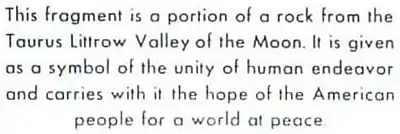Spain lunar sample displays
The Spain lunar sample displays are two commemorative plaques consisting of tiny fragments of Moon specimens brought back with the Apollo 11 and Apollo 17 lunar missions. These plaques were given to the people of Spain by United States President Richard Nixon as goodwill gifts.[1][2]
Description
Apollo 11
The Spain Apollo 11 lunar sample display commemorative plaque consists of four rice-size specimens of lunar rock that were collected by Apollo 11 astronauts Neil Armstrong and Buzz Aldrin in 1969 and a small flag. The four specimens weigh about 0.05 grams in total. They are encased in a clear plastic ball the size of a coin that is mounted to a wooden board approximately one foot square on a small podium pedestal display. The plaque display also has mounted on it a small Spanish flag that had been taken to the Moon and back on Apollo 11. The plaque display was given to the people of Spain as a gift by United States President Richard Nixon. Similar lunar sample displays were also distributed to all the states of the United States and all the countries of the world.[1]
Apollo 17

The Spain Apollo 17 lunar sample display commemorative plaque measures 10x14 inches and consists of one lunar sample that was cut from lunar basalt 70017. This basalt was collected by Apollo 17 astronaut Harrison Schmitt on the Moon in 1972. Once lunar basalt 70017 was brought back to Earth from the Moon, the basalt Moon rock was cut up into small fragments of approximately 1 gram. The specimen was encased in a plastic ball and mounted on the wooden plaque along with the Spanish flag which had been taken to the Moon and back by the crew of Apollo 17. The plaques were then distributed in 1973 by President Richard Nixon to different countries of the world and the States of the United States as a goodwill gesture.[2]
History
There is evidence that the Spanish administration of the 1970s kept the Apollo 11 commemorative plaque display and the lunar samples associated with them as the personal belongings of General Francisco Franco. After Franco's death in 1975 the Apollo 11 "Moon rocks" from his estate were offered to a buyer in Switzerland. Franco's family denies any knowledge of this.[3]

Spanish newspaper El Mundo reported on July 20, 2009 that Franco's grandson, Francisco Franco Martinez Bordiú, claimed the Spanish Apollo 11 lunar samples given to his grandfather in 1973 by the Nixon administration were not gifted to the Spanish people but to his grandfather personally. The Apollo 11 display was kept at El Pardo Palace in Franco's office and were never given to a museum during Franco's administration. After Franco's death in 1975 the Spanish Apollo 11 samples were transferred to the home of Carmen Polo, Franco's wife, and inherited by her only child Carmen Franco y Polo, Bordiú's mother.[4]
Bordiú denied reports that his father, Christopher Martinez Bordiú (Marquis of Villaverde), tried to sell off the Spanish Apollo 11 display in London at one time after his wife had inherited it, but said that in the early 1990s, a friend of the family "made inquiries" to consider selling the space artefact at Sotheby's or another auction house. Bordiu said that his mother had lost the samples, possibly in a remodeling of one of her houses or in the transfer of items from one house to another.[4] The whereabouts of the Spanish Apollo 11 lunar sample remains unknown.[1]
Henry Kissinger, then-Secretary of State during the Nixon administration, gave the Apollo 17 lunar samples to Franco's successor, Admiral Luis Carrero Blanco, in the 1970s. Blanco was killed by the ETA and the Apollo 17 display remained in the possession of the family – first at the home of his widow and then later with his oldest child. Blanco's son ultimately gifted the Apollo 17 samples to the Naval Museum in Madrid in 2007. The commemorative plaque is on display together with the Spanish flag that flew with the Apollo 17 mission to the Moon and back.[4]
Meteorite researcher Jesús Martínez Frías of the Astrobiology Center (CAB) in Madrid was consulted by El Mundo. He argued that the lunar samples are very precious items and should only be in museums and research centers. He believes there should be an international law to control and restrict these items so that they would not show up in the black market later for astronomical prices.[4][5][6][7]
References
- Pearlman, Robert (1999–2012). "Where today are the Apollo 11 goodwill lunar sample displays?". collectspace.com. Retrieved November 2, 2012.
-
- Pearlman, Robert (1999–2012). "Where today are the Apollo 17 goodwill lunar sample displays". collectspace.com. Retrieved November 2, 2012.
- Earth magazine, March 2011, p. 51
- Jáuregui, Pablo (July 20, 2009). "El nieto de Franco: 'Mi madre perdió la piedra lunar que le regalaron a mi abuelo'" [Franco's grandson: 'My mother lost the moonstone that was given to her by my grandfather']. El Mundo (in Spanish). Madrid. Retrieved November 2, 2012.
- Jáuregui, Pablo (July 20, 2009). "El hijo de Carrero Blanco donó otra roca al Museo Naval" [Carrero Blanco's son donated another rock to Naval Museum]. El Mundo (in Spanish). Madrid. Retrieved November 2, 2012.
- Jáuregui, Pablo (July 20, 2009). "El misterio de la roca lunar que EEUU regaló a España" [The mystery of the moon rock that the U.S. gave to Spain]. El Mundo (in Spanish). Madrid. Retrieved November 2, 2012.
- "Apollo moon rocks lost in space? No, lost on Earth". Madrid: Muzi.com. September 13, 2009. Retrieved November 2, 2012.
Further reading
- Kloc, Joe (February 19, 2012). The Case of the Missing Moon Rocks. The Atavist/Amazon Digital Services, Inc. p. 47. ASIN B007BGZNZ8. See *The Case of the Missing Moon Rocks.
